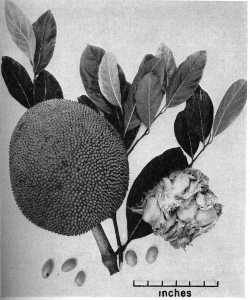Jackfruit, Jak-fruit
Scientific Name: Artocarpus heterophyllus Lam.
Synonym: Artocarpus integra, Artocarpus integrifolius
Family: Moraceae
USDA: 10b-12
Frost Tolerance: Hardy to 32°F (0°C) for short periods, mature trees are reported having survived 26°F (-3°C)
Sun Exposure: Light shade to full sun
Origin: India or Malaysia
Growth Habits: Evergreen tree, 60 feet tall (18 m) or more
Watering Needs: Abundant water and good drainage
Propagation: Fresh seeds, root cuttings. Other methods (air layering, cuttings, buddings) are difficult
The Jack Fruit, a close relative of the breadfruit, is a very large tree cultivated as a novelty in parts of the West Indies. Its fruits are highly prized in Ceylon and other parts of the Asiatic Tropics. Unlike the breadfruit, the leaves of the jack fruit are usually entire and only about 6 inches long. Several related species produce edible fruits or seeds in the Asiatic Tropics. Perhaps the most important of these is Artocarpus odoratissima Blanco, the Marang of the southern Philippines and Borneo. It has larger leaves than the jack fruit and spiny fruits about 6 inches long. The edible pulp and seeds resemble those of the jack fruit. A. champeden (Lour.) Spreng. is cultivated in the Malay Peninsula. Both the flesh and the seeds are eaten.
Fruiting Habits:
The fruits are borne on short lateral branches along the main trunk and larger branches during the humid, rainy season. They are oval to oblong and vary in weight, according to the variety, from 10 to 40 pounds. Although there are reports that they may occasionally exceed 110 pounds in weight. The green rind is made up of hexagonal fleshy spines. The pulp of the fruit is eaten raw or cooked, and it is sometimes used as a vegetable in curries. The seeds are enclosed in slippery, juicy coverings that have a strong pungent odor and a sweet or acid flavor. This part is sometimes combined with other fruits in a fruit salad. The large edible seeds are said to resemble chestnuts after boiling or roasting.
Propagation:
Propagation is by seeds, which have a short period of viability. They should be soaked for 24 hours, and planted in the permanent location as nursery grown plants are difficult to transplant. The seeds germinate in 4 to 8 weeks. Growth is rapid and seed lings may fruit in 3 or 4 years. The trees develop most rapidly in fertile, moist soils.
Desert-Tropicals is dedicated to provide gardening advice, gardening ideas, and information about flower of all kind for landscape and collections.We try to check carefully the identification of the plants on the illustrations as well as the other information from the page, but occasionally errors do occur. if you notice anything that needs to be changed please contact us.Thanks.
© 1998-2020 Philippe Faucon, All Rights Reserved.
